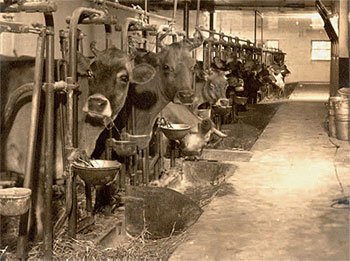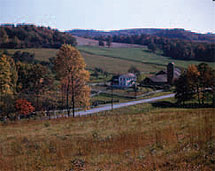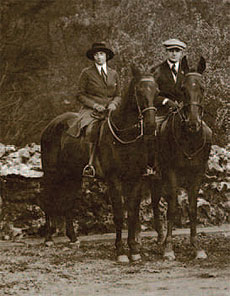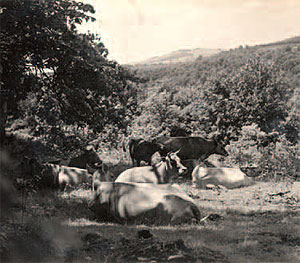The Kaufmann Family Farm at Bear Run

Kaufmann built a state-of-the-art milking parlor for his cows.
In addition to building a department store empire and a house over a waterfall that became instantly famous, Edgar J. Kaufmann was also a gentlemen farmer and avid horseman. Kaufmann pursued this interest by buying neighboring farms and hiring local residents to manage his 1,500-acre property at Bear Run as a working country estate.
Kaufmann’s interest was most likely rooted in his German ancestry, which included horse and cattle dealers. As a child, Edgar could often be found in the store’s livery stables with the horses used to pull the delivery wagons.

A view of the Tissue house and The Barn towards Laurel Ridge.
For Kaufmann, farming was a pastime that allowed him to relax and share something in common with his neighbors. He appreciated the other farmers and showed them the utmost respect, often visiting on horseback to talk about farming and his efforts at Bear Run. He was well-liked in the community.
In 1940, Kaufmann purchased a farmhouse and barn located 500 yards north of Fallingwater that had been built in 1871 by Bear Run farmer Ross Tissue.
Soon he was running a full-fledged dairy operation. In 1943 he expanded the barn with the addition of a modern milking parlor, and operated a dairy with Jersey cows, a breed popular for producing milk with high butterfat content. Herdsmen managed the cattle, as well as his sheep and horses. Kaufmann made sure everything was spotlessly clean. Neighbors reported that the barn was washed down weekly.

Edgar Kaufmann and his wife Liliane rode horses along the Mill Run trails.
Kaufmann’s Jersey cows often won the top prize at the Mill Run Community Fair. The fair was an opportunity for local farmers to display their livestock, vegetables, fruits, jellies and other goods.
Kaufmann was an active member of the Mountain Top Co-op, a dairy cooperative that bargained for better prices for local milk. He attended the co-op’s banquets, but more than that, he brought business acumen to the co-op. When the dairy cooperative lost its regular milk bottler, he secured the help of I.N. Hagan of Hagan Dairy Company in Uniontown to replace it. Kaufmann also introduced him to Frank Lloyd Wright, who later designed the Hagans’ country home, Kentuck Knob, just seven miles south of Fallingwater.
Eggs from Kaufmann’s chickens were transported to Pittsburgh, where department store customers and office workers “clamored” to buy them, according to Kaufmann’s secretary, Ethel Clinton.

Kaufmann’s Jersey cows grazing in the pasture near the barn, circa 1940.
Plenty of sheep also grazed in the pasture at the Bear Run Farm. Elsie Henderson, former cook for the Kaufmanns, is quoted in The Fallingwater Cookbook by Suzanne Martinson: “When you came down the hill past the barn you thought it had snowed, there were so many wooly, white lambs.” The Kaufmanns enjoyed healthy farm-to-table meals at Fallingwater as a result of their agricultural endeavors.
The Kaufmanns shut down the dairy operation in 1951, and began reforestation shortly thereafter to help protect Bear Run Stream from erosion and flooding. In 1963, Edgar Kaufmann jr. entrusted the regenerating forestland to the Western Pennsylvania Conservancy as a nature reserve at the time of his donation of Fallingwater.
The dairy barn sees new life today as a public meeting and exhibition space and WPC staff offices. The Barn’s complete LEED (Leadership in Energy and Environmental Design) certified renovation focused on sustainable building practices, including use of recycled materials throughout the space. The barn was named one of the top ten green projects in 2005 by the American Institute of Architects.
